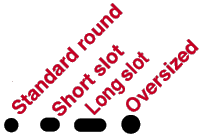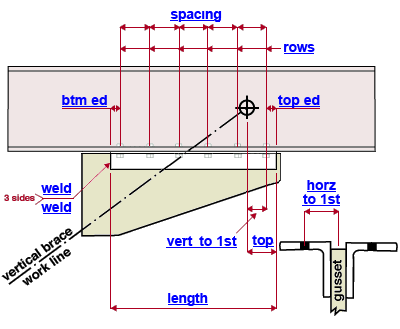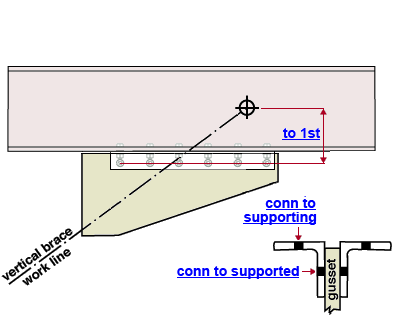"  NS/FS Clip Conn2 " connection design locks
NS/FS Clip Conn2 " connection design locks
| " |
|
||||||
|
"
|
" (shop ' Bolted ' to the gusset)
|
|||||
|
||||||
Connection Guide: Click here .
User Defined Connections: Settings that are locked (
) in the user defined connection file will automatically be locked on the member edit window. You can, if you so choose, manually lock additional settings on the member edit window, and your changes will be retained, through multiple processes, so long as you do not change to a different connection then switch back to the original user defined connection.
Vertical Brace Edit: To change a setting, first set it to locked (
). Related settings that are unlocked (
) may be updated, and the "
Left/Right end limit state " calculations will be updated. Settings that are locked (
) will not be changed by connection design , even if doing so might prevent a connection failure.
Connection design locks :
| Locks not called out or dimensioned on the drawing are marked ( not depicted ). |
![]() NS/FS Clip Conn2
NS/FS Clip Conn2
( vertical brace to a beam )
Clip angle
Section size ( not depicted ): The angle material to be used for the NS or FS gusset clip angle. For example, ' L4x3x5/16 '. The angle you enter must exist in the local shape file, or validation will not accept your entry. To enter an angle section size, you can type in the section size that you want, or you can press the "file cabinet" browse button (
) and double-click any section that is on the list of available angles in the local shape file . If you are in the "
NS Clip Conn2 " leaf, the section size entered here is the NS gusset clip angle.
Long leg to ( not depicted ): Supported or Supporting . This applies when the " Section size " is an angle with unequal legs. If you want the long leg of the clip angle to fasten to the gusset plate, select ' Supported '. If you want the long leg of the clip angle to fasten to the supporting beam, select ' Supporting '.
Top of angle ( top ): The positive (+) or negative (-) distance (parallel with the length of the angle) from the work point of the vertical brace to the "top" of the gusset clip angle. In the example above, the "top" of the angle is its right end and " Top of angle " is a negative number. A " Top of angle " of ' 0 ' aligns the "top" of the angle with the brace's work point. Entering a positive (+) distance moves the angle parallel with the work line of the beam toward the opposite end of the brace. Entering a negative (-) distance moves the angle parallel with the work line of the beam in the direction that this end of the vertical brace points toward (right in the above example). Changing the " Top of angle " moves the clip angle only, not the holes in the angle.
Length of angle ( length ): The length (parallel with the work line of the beam) of the longest edge of the clip angle (see example ). Assuming that this field is unlocked, changing the number of " Rows " or the " Vertical hole spacing " also changes the " Length of angle ."
Connection to supported (gusset clip angle, NS or FS, leg welded or bolted to the gusset plate) :
When "
Connection specifications " > " Gusset to clip connection " is set to ' Welded ', you get a " Weld size " entry field, but no options for bolting:
Weld size ( weld ): The weld size used to shop weld the "
NS Clip Conn2 " or "
FS Clip Conn2 " clip angle to the gusset plate (see example ).
When " Gusset to clip connection " is set to ' Bolted ', you get the following " Connection to supported " options for shop bolting the brace to the gusset plate. " Connection to supported " settings can be different than the entries made to " Connection to supporting " fields.
Bolt diameter ( not depicted ): May be different than the " Bolt diameter " in the leg to supporting.
diameter of leg-to gusset shop bolts 
Hole type ( not depicted ): The value entered here, for the leg to gusset, may be different than the " Hole type " in the leg to the supporting (beam).
Rows ( not depicted ): The value entered here, for the leg to gusset, may be a different number than the " Rows " in the leg to supporting.
Vertical to 1st hole ( not depicted ): If, for the " Connection to supported ," you enter a " Vertical to 1st hole " to the "
NS Clip Conn2 " leaf that is different than the connection-to-supported " Vertical to 1st hole " in the "
FS Clip Conn2 " leaf, the program emits the failure message described below.
End connection failure message: Locked vertical to 1st hole value on supported must match .
Vertical hole spacing ( not depicted ): It is permissible to have leg to gusset hole spacing that is different than the " Vertical hole spacing " in the leg to supporting.
Top vertical edge distance ( not depicted ): You can enter a leg-to-gusset top vertical edge distance that is different than the " Top vertical edge distance " in the leg to supporting.
Bottom vertical edge distance ( not depicted ): You can enter a leg-to-gusset bottom vertical edge distance that is different than the " Bottom vertical edge distance " in the leg to supporting.
Horizontal to 1st hole ( to 1st ): The distance (perpendicular to the length of the angle) from the work point on the beam to the center of the holes in the leg that bolts to the gusset plate (see example ). For a non-sloping beam, this distance is vertical.
Connection to supporting (gusset clip angle, NS or FS, leg that shop bolts to the supporting beam) :
Bolt diameter ( not depicted ): The diameter of shop bolts for fastening the gusset clip angle to the supporting beam. You can either type a diameter (inches or mm), or you can select a bolt diameter from the combo box (
). The diameters that are listed in the combo box come from Home > Project Settings > Job > Bolt Settings > the " Available bolt diameters " list. The bolt diameter entered here together with the " Hole type " entered below sets the diameter of holes in the leg.
diameter of shop bolts for the leg to the beam 
Hole type ( not depicted ): Standard round or Short slot or Oversized or Long slot or User slot #1 or User slot #2 . The hole type selected here, together with the " Bolt diameter " entered above, set the diameter of holes for shop bolting the leg of the gusset clip angle to the beam.

Rows: The number of bolt holes in the gusset clip angle leg to the supporting beam. In the example above, the number of " Rows " is ' 6 '. If the " Length of angle " is not locked, then changing the number of " Rows " causes the angle length to be recalculated.
Vertical to 1st hole ( vert to 1st ): The positive (+) or negative (-) distance (parallel with the length of the angle) from the work point of the vertical brace to the center of the hole nearest the "top" of the clip angle (see example ). A " Vertical to 1st hole " of ' 0 ' aligns the first hole in the clip angle with the brace's work point. Entering a positive (+) distance moves the hole parallel with the work line of the beam toward the opposite end of the vertical brace. Entering a negative (-) distance moves the hole parallel with the work line of the beam in the direction that this end of the vertical brace points toward (toward the right end of the beam, horizontally, in this example).
End connection failure message: Locked vertical to 1st hole value on supporting must match
Vertical hole spacing ( spacing ): The distance (center to center) between any two adjacent holes in the gusset clip angle's leg to the supporting beam (see example ). Vertical hole spacing runs parallel with the work line of the beam and the length of the clip angle (horizontally if the beam is horizontal). If the " Length of angle " is unlocked (
), then changing the " Vertical hole spacing " changes the angle length. Instead of entering a single vertical spacing distance, you can enter variable hole spacing. See the video and table below.
VIDEO 
Variable hole spacing can be typed to locked " Vertical hole spacing " fields found in leaves named " Shear Tab "; "
Bent Plate " "
End Plate " and "
NS/FS Clip ."
Rows Spacing Result 5 3,5,3,3 4 spaces at 3", 5", 3" and 3" 5 3,5,2@3 4 spaces at 3", 5", 3" and 3" 5 3,5,3 4 spaces at 3", 5", 3" and 3"
(the last spacing -- 3 -- is repeated to fill the spaces that are required for the number of rows)5 3,5,3,3,2,3 End connection failure message (see below). End connection failure message: Variable row spacing specifies too many rows
Top vertical edge distance ( top ed ): The distance (parallel with the length of the angle) from the "top" of the gusset clip angle to the center of the nearest hole in the leg to the supporting beam. If the beam is horizontal, the " Top vertical edge distance " is dimensioned horizontally. See the example .
Bottom vertical edge distance ( ): The distance (parallel with the length of the angle) from the "bottom" hole in the leg-to-supporting-beam's hole group to the "bottom" of the gusset clip angle. See the example .
Horizontal to 1st hole ( horz to 1st ): The distance (perpendicular to the length of the angle) from the work point (center of gusset plate) to the column of holes in the clip angle leg that bolts to the supporting beam. If " Horizontal to 1st hole " is the same in both the NS and FS gusset clip angles, the value entered to each is equivalent to half the center-to-center distance between the holes in the outstanding legs of those NS and FS angles. See the example .









